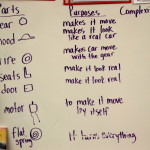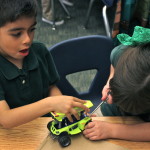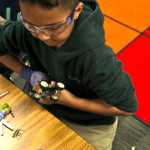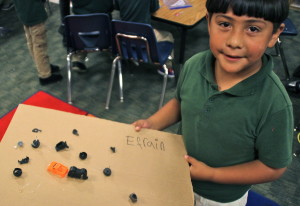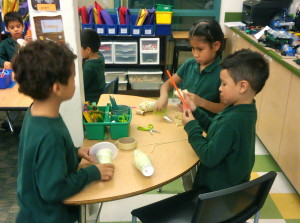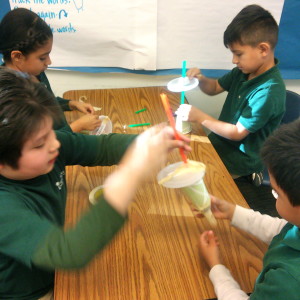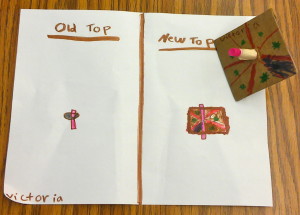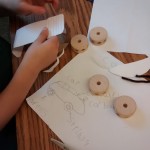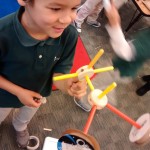Projects using toys are immediately engaging for students, and can provide surprising learning opportunities. Our first grade class had a whole unit on toys; they took apart toy cars to learn about how they worked, built tops (while learning some basic physics concepts), and designed new toys from scratch using a variety of materials.
They started the take-apart activity using Parts, Purposes, Complexities to think about how toys work (and safety!) through class discussion…
- Parts and purposes of toy parts
- Ways toys move
- Tool safety!
Here they are taking apart toy cars in class, after which they explored the parts and purposes of their toys.
- Two students work together to take apart a car.
- A student wears gloves and goggles when prying things apart.
- A student wears gloves and goggles while using a sharp tool.
Some close-ups of their completely taken-apart cars. They used the parts to create wall tiles so they could share their work during our Winter Expo (similar to a back-to-school night).
- Effrain shows us his toys’ parts.
- Parts are displayed on a cardboard tile for examination by the class.
Then the moved on to building tops, with a variety of materials — we used cups, plastic lids, cardboard squares, skewers, straws, and golf pencils.
- Students create tops (round 1).
- Students create new tops (round 2).
Students record multiple iterations of their design. This can also lead into writing practice, where they explain what changes they made, which one worked better, and why they think it did.
- A student shows two iterations of top design.
- A student shows two very different tops; a small round one, and a larger square one.
And finally, they designed new toys, based on their understanding from the take-apart and tops-building activities!
- A student creates a mixed-media car; her design shows the materials each part will be made of.
- A student uses tinker toys and ribbon spools to create a spaceship.
- A student shows their original design, and their finished toy.
Students were encouraged throughout the process of making their toys look like their designs, and were generally very accurate. Notice the gemstone mouth on the heart toy and the description on the plans for the car of what materials they were going to use. The final picture is an example of a student who went on a bit of a design tangent when unexpected materials were introduced; he combined tinker toys and empty ribbon containers to make a space ship.
About Cissy Monroe
Cissy has been a Maker long before the term came into popular usage. She is a seamstress, origami and papercrafts enthusiast, and occasionally has the patience for knitting, crochet, and woodworking. For the past 5 years, she has worked as a cook -- most recently at a public school in Sonoma County that provides organic, made-from-scratch breakfasts and lunches for their students. She returned to college a year ago to complete a degree in Environmental Studies, and from there plans to pursue a teaching credential for high school biology. She joined the Creativity Lab staff through the AmeriCorps VISTA program this August. Her position as the Curriculum and Documentation Coordinator at Lighthouse will allow her explore new (to her) aspects of Making, while also supporting teachers to integrate Making into their curricula. She looks forward to sharing their projects with you here.
